

From Jacobite to Conservative - James J. Sack. The Jacobite Relics of Scotland: Being the Songs, Airs, and Legends of the ... The engraved record of the Jacobite movement - OpenBibArt. Title : Author : SHARP, Richard ; Publication year : Language : Abstract : The history of the Jacobite rising can be charted through the large number of engravings that exist on the subject.
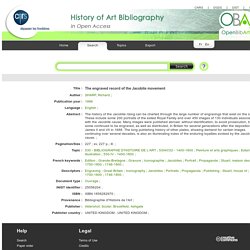
Pagination/Size : 227 ; xv, 227 p.; ill Topic : 530 - BIBLIOGRAPHIE D'HISTOIRE DE L'ART ; 5304C02 - 1400-1800 ; Peinture et arts graphiques ; Estampe et illustration ; 530-IV - 1400-1800 ; French keywords : Edition ; Grande-Bretagne ; Gravure ; Iconographie ; Jacobites ; Portrait ; Propagande ; Stuart, maison des ; 1700-1800 ; 1746-1800 ;
Revolution, Restoration, and Debt Repudiation: The Jacobite Threat to England's Institutions and Economic Growth. Maps of Scotland before 1850 - Maps Collections. This guide gives a brief summary of some of the types of maps produced from the late 16th to mid-19th centuries.
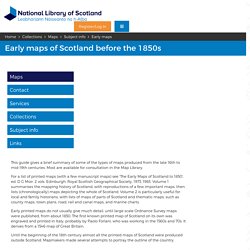
Most are available for consultation in the Map Library. For a list of printed maps (with a few manuscript maps) see 'The Early Maps of Scotland to 1850', ed. D G Moir. 2 vols. Edinburgh: Royal Scottish Geographical Society, 1973, 1983. Volume 1 summarises the mapping history of Scotland, with reproductions of a few important maps, then lists (chronologically) maps depicting the whole of Scotland. Early printed maps do not usually give much detail, until large scale Ordnance Survey maps were published, from about 1850. Scottish History - Summary Index. When it became clear to the "Butcher" Cumberland the Jacobites were giving ground at Culloden, he gave the "no quarter" order.

Now, the most hated phrase in the Highlands. Hundreds of fallen soldiers, not dead, were shot where they lay, others were burned alive in human fire pits. Many were taken prisoner only to be summarily shot, one after the other. Memorial Cairn at Culloden According to authors Somerst Fry. Later, the Duke of Cumberland, (the son of Britains King, Geroge II), would complain that he'd actually been asked to show no humanity. The atrocities that occurred immediately after Culloden in the "Pacification" -- such a horrifying devastation of the Highlands -- was backed by the London Government and applauded by many Lowland and Presbyterian Scots who hated the Highlanders as much for their stubborn adherence to the Roman Catholic Faith as much as their loyalty to the Stewarts.
Scottish Highlander. 17th and 18th Century Scottish Costume. It is hard to emphasize enough the lack of information about clothing in the Scottish Highlands until the middle of the 1600s, but around the late 1500s to early 1600s, Scottish Highland clothing became more distinct from Irish clothing of the same period.

Whereas the Irish began to wear clothing that more closely resembles that of the common English peasantry, the Scottish Highlanders adopted and kept several forms of clothing such as the bonnet and plaid, both of which were originally worn in the Lowlands and then migrated into the Highlands, where they developed their own distinct forms. Moreover, checkered cloth, which was worn to some extent in Celtic cultures throughout history (usually as simple checks and two-color patterns), becomes highly developed, and a multitude of patterns can be found in the portraits of Highland chiefs and their followers dating from the middle of the 1600s onward. The Appin Regiment's guidelines for men's and women's clothing. The Real Deal on Tartan, Kilts, and Outlander Costumes. Frock Flicks note: Today we feature a detailed review of the costumes in Outlander by Brenna Barks, an expert on Scottish dress and 18th-century fashion (and a Frock Flicks reader!).
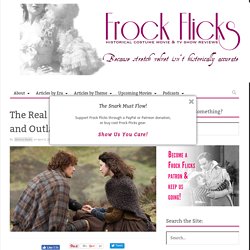
As soon as Kendra met Brenna and heard the words “studied Scottish dress as part of my master’s degree,” she said “REVIEW OUTLANDER FOR US!” For more on Brenna, you’ll find a bio at the end of this post. We’re excited to bring you such a detailed review written by someone who really knows her stuff. As the only student in my class of the (Art) History, Theory and Display taught programme at the University of Edinburgh looking at dress and textile history – material culture more generally – it’s really not a surprise that the majority of papers I wrote that year were on tartan and Scottish dress.
What started as a curiosity and an “easy” topic to research and use as the basis for a truly terrible virtual exhibition project has grown into a driving passion. Second, a word on terminology. Stewart Tartan. Scottish Music in the 18th Century. Musical instruments are usually classified according to how they work physically, i.e. wind instruments are distinguished from string instruments, and so on.
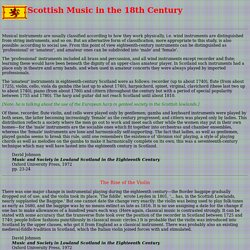
But an alternative form of classification, more appropriate to this study, is also possible: according to social use. From this point of view eighteenth-century instruments can be distinguished as 'professional' or 'amateur', and amateur ones can be subdivided into 'male' and 'female'. The 'professional' instruments included all brass and percussion, and all wind instruments except recorder and flute; learning these would have been beneath the dignity of an upper-class amateur player. In Scotland such instruments had a place only in theatre and army bands, and when used in amateur concerts they were always played by imported professionals. Map showing the districts of the highland clans of Scotland.
1740s Scottish Jacobite garb. History - Scottish History. Bonnie Prince Charlie and the Jacobites, Scotland - UK History. Scottish history. Charting the Nation: maps of Scotland, 1550-1740: Homepage. Black Watch Origins : Print Technology in Scotland and America, 1740–1800 - Louis Kirk McAuley. Undiscovered Scotland: Timeline of Scottish History: 1740 to 1800. 29 October 1740: The birth in Edinburgh of James Boswell, the lawyer, diarist, traveller and author. 28 April 1742: The birth in Dalkeith of Henry Dundas, 1st Viscount Melville, the lawyer and politician who became the last person to be impeached in the United Kingdom.
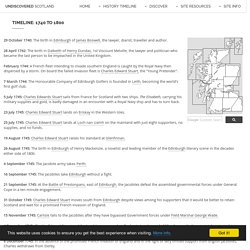
February 1744: A French fleet intending to invade southern England is caught by the Royal Navy then dispersed by a storm. On board the failed invasion fleet is Charles Edward Stuart, the "Young Pretender". 7 March 1744: The Honourable Company of Edinburgh Golfers is founded in Leith, becoming the world's first golf club. 5 July 1745: Charles Edwards Stuart sails from France for Scotland with two ships. Rebellion and Savagery: The Jacobite Rising of 1745 and the British Empire - Geoffrey Plank.